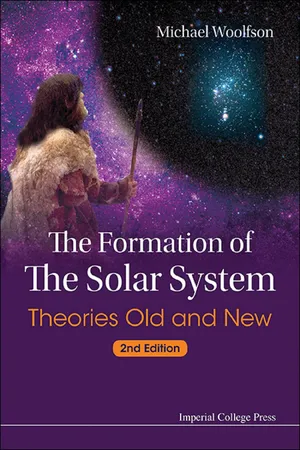
- 440 pages
- English
- ePUB (mobile friendly)
- Available on iOS & Android
About This Book
This fully-updated second edition remains the only truly detailed exploration of the origins of our Solar System, written by an authority in the field. Unlike other authors, Michael Woolfson focuses on the formation of the solar system, engaging the reader in an intelligent yet accessible discussion of the development of ideas about how the Solar System formed from ancient times to the present.
Within the last five decades new observations and new theoretical advances have transformed the way scientists think about the problem of finding a plausible theory. Spacecraft and landers have explored the planets of the Solar System, observations have been made of Solar-System bodies outside the region of the planets and planets have been detected and observed around many solar-type stars. This new edition brings in the most recent discoveries, including the establishment of dwarf planets and challenges to the 'standard model' of planet formation — the Solar Nebula Theory.
While presenting the most up-to-date material and the underlying science of the theories described, the book avoids technical jargon and terminology. It thus remains a digestible read for the non-expert interested reader, whilst being detailed and comprehensive enough to be used as an undergraduate physics and astronomy textbook, where the formation of the solar system is a key part of the course.
Michael Woolfson is Emeritus Professor of Theoretical Physics at University of York and is an award-winning crystallographer and astronomer.
Contents:
- Introduction
- Introduction to the Second Edition
- Prologue: The Dreamer
- General Background:
- Theories Come and Theories Go
- Measuring Atoms and the Universe
- Enlightenment:
- Greek Offerings
- The Shoulders of Giants
- The Solar System: Features and Problems:
- The Sun and the Planets
- Satellites and Rings
- Smaller Bodies of the Solar System
- The Problem to be Solved
- Early Theories:
- The French Connection
- American Catherine-Wheels
- British Big Tides
- Russian Cloud Capture — With British Help
- German Vortices — With a Little French Help
- McCrea's Floccules
- What Early Theories Indicate
- New Knowledge:
- Disks Around New Stars
- Planets Around Other Stars
- What a Theory Should Explain Now
- The Return of the Nebula:
- The New Solar Nebula Theory: The Angular Momentum Problem
- Making Planets Top-Down
- A Bottom-Up Alternative
- Making Planets Faster
- Wandering Planets
- Back to Top-Down
- Making Stars:
- This is the Stuff that Stars are Made Of
- Making Dense Cool Clouds
- A Star is Born, Lives and Dies
- Capture:
- Close to the Madding Crowd
- Close Encounters of the Stellar Kind
- Ever Decreasing Circles
- How Many Planetary Systems?
- Starting a Family
- Tilting — But not at Windmills
- The Biggish Bang Hypothesis:
- The Terrestrial Planets Raise Problems
- A Biggish Bang Theory: The Earth and Venus
- Behold the Wandering Moon
- Fleet Mercury and Warlike Mars
- Gods of the Sea and the Nether Regions
- Bits and Pieces — Asteroids, Comets and Dwarf Planets
- Making Atoms with a Biggish Bang
- Is the Capture Theory True?
- Epilogue: An Autumn Evening
Readership: Professionals and general readers interested in astronomy and cosmology. Key Features:
- It explains the science in a narrative style using a minimum number of equations while preserving scientific integrity
- In developing the progress of ideas historically it shows how components of failed theories can be incorporated in new theories, making positive contributions to the subject
- It includes all the most recent observations that must be accounted for in any viable theory
Frequently asked questions
Information
Table of contents
- Cover
- Half Title
- Title Page
- Copyright
- Contents
- Introduction
- Introduction to the Second Edition
- Prologue
- Part I. General Background
- Part II. Enlightenment
- Part III. The Solar System: Features and Problems
- Part IV. Early Theories
- Part V. New Knowledge
- Part VI. The Return of the Nebula
- Part VII. Making Stars
- Part VIII. Capture
- Part IX. The Biggish Bang Hypothesis
- Epilogue
- Bibliography
- Index